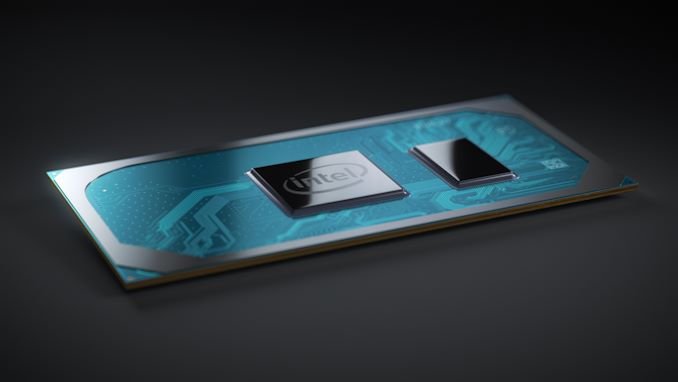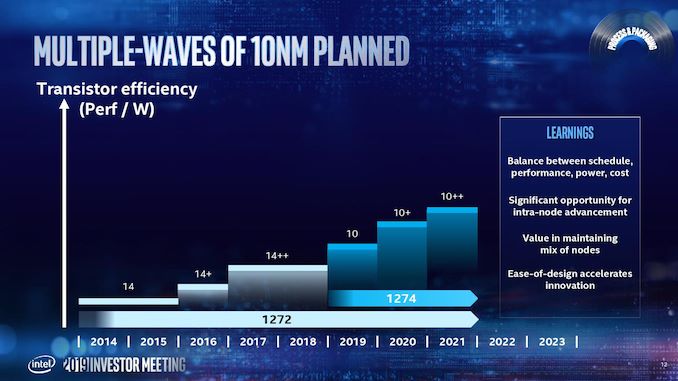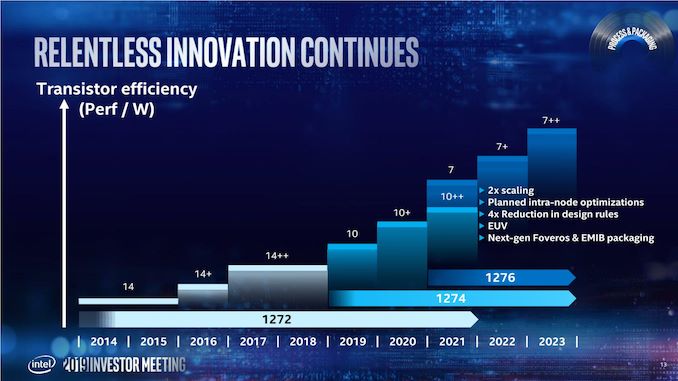Intel Q3 2019 Fab Update: 10nm Product Era Has Begun, 7nm On Track
by Anton Shilov on October 28, 2019 9:30 AM EST
After years of delays, Intel is finally shipping its 10 nm processors in high volume, and the company is preparing to fire up another fab to produce an even larger volume of 10nm products. Along with producing more of the company's existing Ice Lake-U/Y products, Intel is also planning for server CPUs and GPUs as well, with Ice Lake-SP CPU as well as the DG1 GPU already up and running in Intel’s labs. Meanwhile, even farther out, Intel is eyeing 2021 for the rollout of its EUV-based 7nm process.
During its earnings call on Thursday, Intel said that so far 18 premium systems based on its 10th Generation Core (Ice Lake) processors have been formally introduced and 12 more are expected in 2019. Right now, the company produces all of its 10 nm CPUs in Hillsboro, Oregon and Kiryat Gat, Israel. Starting next quarter, the company expects 10 nm chips to also ship from its Chandler, Arizona, fab, which will increase supply of Ice Lake processors and will get Intel prepared for a broader use of the manufacturing process that had caused company a lot of troubles.
In addition to client Ice Lake CPUs and Agilex FPGAs that are currently shipping, Intel’s 10 nm portfolio includes datacenter-grade Xeon (Ice Lake-SP) processors due in the second half of 2020, discrete DG1 GPU(s), an AI inference accelerator, and a 5G base station SoC. One thing to keep in mind here is that Intel will use different iterations of its 10 nm technology to make different chips.
Here is what Bob Swan, CEO of Intel, said:
“The Intel 10 nm product era has begun and our new 10th Gen Core Ice Lake processors are leading the way. In Q3, we also shipped our first 10 nm Agilex FPGAs. In 2020, we will continue to expand our 10 nm portfolio with exciting new products including an AI inference accelerator, 5G base station SoC, Xeon CPUs for server storage and network, and a discrete GPU. This quarter we have achieved power on exit for our first discrete GPU DG1, an important milestone.”
The big news here is that Intel produced the first samples of its DG1 GPU back in Q3, which means that the company now has actual silicon to work with. The chip will undergo at least one more iteration before it will be ready to ship commercially, but it is a good sign that Intel’s A0 DG1 GPU could be turned on. If Intel wants to launch these GPUs in mid-2020, then this is the right window to begin working on actual silicon.
One of the key operational challenges that Intel faces today in regards of its 10 nm fabrication process are yields, as they thwarted the technology from going HVM (high volume manufacturing) for years. According to Intel, yields are improving ahead of expectations for both for client and datacenter CPUs, though the company did not disclose any numbers.
7nm Technology on Track, 5nm in Development
Meanwhile, with their 10 nm evolution roadmap set till 2021, Intel’s manufacturing technology teams are now focused on 7 nm and 5 nm processes. Along with their 10nm status update, in their earnings call Intel has re-iterated that its EUV-based 7 nm technology was on-track for HVM in 2021, and that development of its 5 nm node was proceeding as planned.
According to Intel, having learnt from its 10 nm fabrication process and how its problems harmed its roadmap, the company has radically changed its approach to development of manufacturing technologies and actual products. The company no longer sets ultra-ambitious goals for scaling each node, but attempts to find a right balance between performance, power, cost, and timing. Furthermore, the manufacturer no longer designs products for a particular process, but intends to use the most optimal one it has at the moment. Overall, Intel says that it intends to get back to its usual process technology cadence and introduce brand-new technologies every 2 to 2.5 years, and recapture its process leadership in the future.
Intel’s first product to be made using its 7 nm manufacturing technology is its ‘big’ GPU for high performance computing that is due in Q4 2021, two years after the launch of the 10 nm Ice Lake CPU. Intel says that its 7 nm process is well on-track and the product will be released as planned. While Intel also plans to use 7+ and 7++ technologies in 2022 and 2023, the company is already working on its 5 nm process and is currently ‘engineering’ it, which means that the path-finding stage has been passed and fundamental things like materials and transistor structures were set.
Here is what Bob Swan, CEO of Intel, told analysts and investors on Thursday:
“We are on track to launch our first 7 nm based product, a datacenter-focused discrete GPU, in 2021, two years after the launch of 10 nm [products]. We are also well down the engineering path on 5 nm.”
Related Reading:
- Intel Begins Commercial Shipments of 10nm Ice Lake CPUs to OEMs
- The Ice Lake Benchmark Preview: Inside Intel's 10nm
- Examining Intel's Ice Lake Processors: Taking a Bite of the Sunny Cove Microarchitecture
- Intel Details Manufacturing through 2023: 7nm, 7+, 7++, with Next Gen Packaging
- Intel Process Technology Update: 10nm Server Products in 1H 2020, Accelerated 7nm in 2021
Source: Intel












59 Comments
View All Comments
Yojimbo - Monday, October 28, 2019 - link
The use of EUV does affect the performance of the chip that is produced... The world is complicated. Transistors are physical things with defects and characteristics that can depend on the method used to make the transistors. Per the CEO of ASML (the maker of the EUV lithography tools) one reason DRAM manufacturers are looking at EUV for their future DRAM process nodes is the performance of the chips made using EUV compared with those using multipatterned DUV.name99 - Monday, October 28, 2019 - link
NO. Intel want to look like it's copying TSMC. That's different from actually copying them...The superficial difference are clear
- the bragging (OMG, they just cannot control themselves, can they?) about 2x density
- the pre-announcement years in advancement rather than not announcing till details are set.
But those are superficial. More important is how process evolves.
- Intel's +, ++ etc advances seem like extreme optimizations of an existing process. Meaning that they get better yield and better transistors for that process BUT it's very process specific. There's no evidence that what you learn in moving from 14nm+ to 14nm++ helps you much in going from 10nm to 10nm+.
- TSMC's advances are mostly more generic. This year lithography gets better for metal layers. Next year the basic transistor cell gets smaller (SDB, COAG, that sort of thing). The year after that GAA gets introduced. These are all improvements that can be built upon, unlike Intel's improvements.
This COULD change with 10nm (it's not clear even Intel knows what it's doing, so certainly outsiders don't!) But it's not what Intel has been doing so far.
outsideloop - Monday, October 28, 2019 - link
This is like listening to a substance abuser: "I am on a different path and am changing my ways. The past is behind me now. I am looking forward to better things in the future." Its always just worthless talk.5080 - Monday, October 28, 2019 - link
Crazy, by the time they have 7nm TSMC is already on 3nm+drothgery - Monday, October 28, 2019 - link
I wouldn't be shocked if Intel re-brands their 5nm process as "4nm" or "3nm" since there's even less correlation between marketing names for processes and any physical dimensions than there was ten years ago.haukionkannel - Tuesday, October 29, 2019 - link
Intel 7nm maybe Denver than TSMC 3nm... that marketing nm has gone out of any meaning Many years ago...5080 - Tuesday, October 29, 2019 - link
Not really, actually it has been narrowed over the last couple of years. Intel's 10nm is about 8.5nm on competing processes. Intel's 7nm is closer to TSMC's 6nm process. This is based on the transistor density per square inch.mooninite - Monday, October 28, 2019 - link
What 10nm products has Intel shipped for two years? Customer only stuff? I don't know of anything from 2017 that was 10nm... Someone want to report the CEO for lying to the SEC?DanNeely - Monday, October 28, 2019 - link
The only "two years" I see in the article is the timeline for 7nm. Two years from now in 2021. The slide for process techs even dropped the polite fiction that they shipped 10nm at the very end of 2018 (a crappy mobile cpu without graphics in a few China only laptops).MrCommunistGen - Monday, October 28, 2019 - link
Splitting hairs, but Intel also released a couple Canon Lake NUCs:NUC8i3CYSN
NUC8i3CYSM
I have no idea what kinds of numbers those shipped in -- but I'd bet that total volume was pretty low.
As I commented in the Anandtech Canon Lake review(where Ian reviewed the Chinese laptop back in January 2019) the NUC was expensive and was limited to 8GB of soldered down RAM.